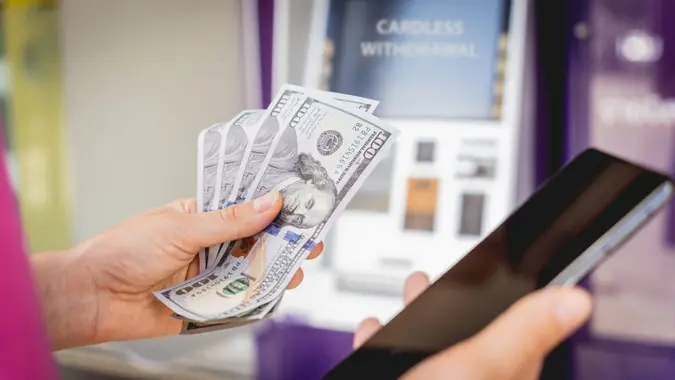Rachel Cruze: Here’s How Much Cash To Keep in the Bank

Commitment to Our Readers
GOBankingRates' editorial team is committed to bringing you unbiased reviews and information. We use data-driven methodologies to evaluate financial products and services - our reviews and ratings are not influenced by advertisers. You can read more about our editorial guidelines and our products and services review methodology.

20 Years
Helping You Live Richer

Reviewed
by Experts

Trusted by
Millions of Readers
Especially when the economy is uncertain or you’re in a fragile financial situation, having cash provides security in case of income swings or unexpected expenses. But the amount of money kept in the bank matters since some accounts don’t pay rates that help you beat inflation.
According to money expert Rachel Cruze, your lifestyle, income and priorities come into play when deciding the right amount to have in your checking and savings accounts. Her recent YouTube video offered some guidelines to help you avoid keeping too little or too much cash.
Emergency Savings
Cruze mentioned a 2023 Federal Reserve report showing that around 40% of Americans wouldn’t have enough cash for a $400 unexpected expense. This shows the importance of having easily accessible money ready for emergencies.
According to Cruze, you should start with a $1,000 emergency fund. Use a high-yield savings account so you get a much better return (often 3% to 5%) on your cash than the 0.41% national average reported by the Federal Deposit Insurance Corporation.
“The next goal that you’re going to have is bump up that savings to three to six months’ of expenses once you are out of debt,” Cruze said.
For example, if your expenses total $3,000 each month, you’d aim for a $9,000 to $18,000 emergency fund.
While having more emergency savings, like one year’s worth, might seem smart, Cruze advised against it. You’d likely miss out on higher-earning opportunities.
Retirement Savings
“Your savings needs to continue on, so having a rhythm in your life where you are saving 15% of your money for the future is really, really key,” Cruze explained.
For example, if you’re earning $75,000 per year, your 15% goal would be putting $11,250 toward your retirement savings through automatic or manual contributions.
You should research your account options, such as your job’s 401(k) with a potential employer match or a Roth or traditional IRA with varying tax benefits. These accounts let you contribute up to annual limits, and you can usually take advantage of both.
Plus, consider your retirement income needs and planned retirement age since you might need to adjust your savings strategy. Fidelity suggested savings milestones to determine if you’re on track, such as having six times your income by age 50 and eight times your income by age 60.
Checking Account
According to Cruze, the amount to keep in your checking account varies depending on several factors, like your spending habits, income, dependents, homeownership status and personality. However, you should have enough to cover bills drafted from the account.
Cruze gave tips that can help you work out an amount. She recommended budgeting so your checking account funds have specific purposes and adding a miscellaneous category for unexpected expenses. Plus, she advised keeping a paycheck-sized cushion so you’re less dependent on your next payday.
Try to avoid keeping excess money in checking since you’re likely earning a very low interest rate at best — and that’s if your account offers any at all. Watching your transactions and ending checking account balance can help you determine adjustments.
More From GOBankingRates
- Nearly 1 in 3 Americans Hit by a Costly Holiday Scam, Norton Survey Shows -- How To Avoid This
- Here's What Retirees Wasted the Most Money On in 2025 -- and How To Avoid It in 2026
- How Middle-Class Earners Are Quietly Becoming Millionaires -- and How You Can, Too
- 6 Safe Accounts Proven to Grow Your Money Up to 13x Faster
 Written by
Written by  Edited by
Edited by 

























